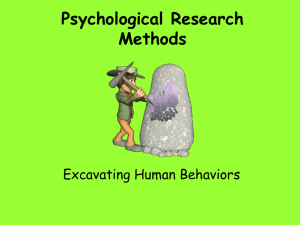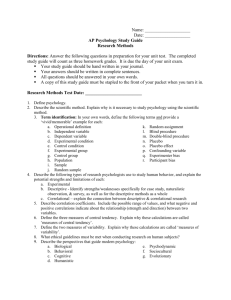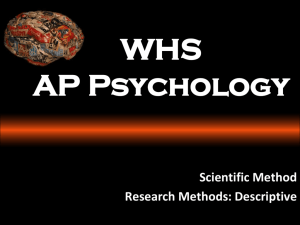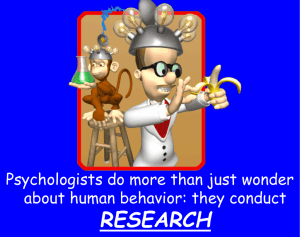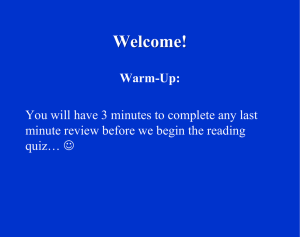Guided Notes – Research Methodology
advertisement
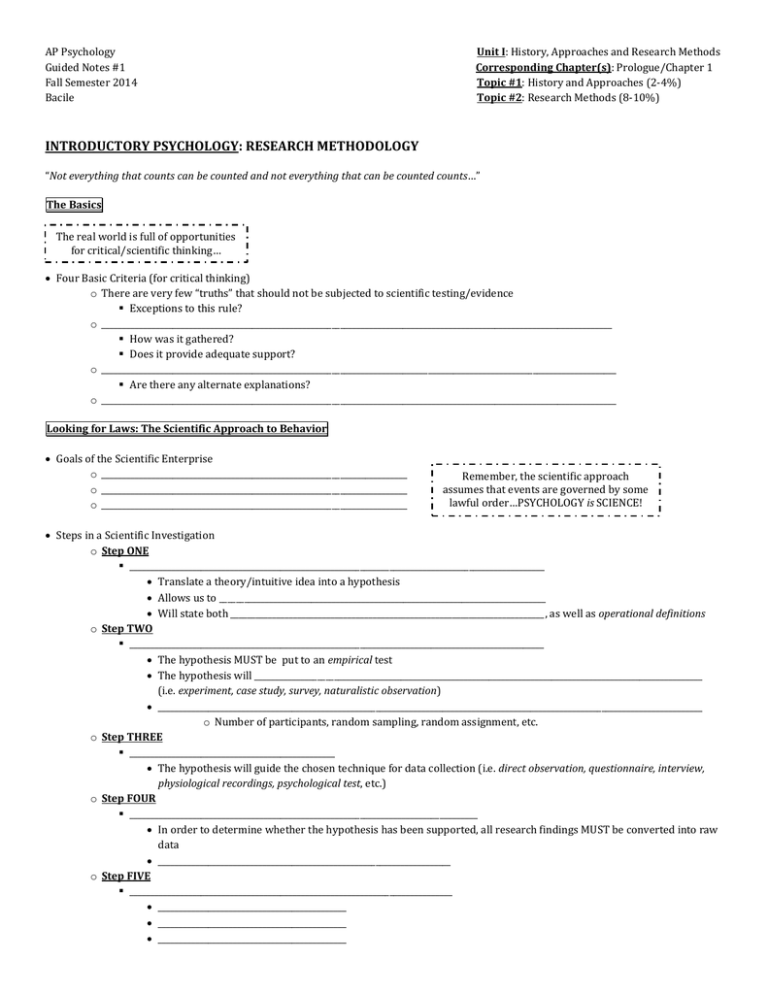
AP Psychology Guided Notes #1 Fall Semester 2014 Bacile Unit I: History, Approaches and Research Methods Corresponding Chapter(s): Prologue/Chapter 1 Topic #1: History and Approaches (2-4%) Topic #2: Research Methods (8-10%) INTRODUCTORY PSYCHOLOGY: RESEARCH METHODOLOGY “Not everything that counts can be counted and not everything that can be counted counts…” The Basics The real world is full of opportunities for critical/scientific thinking… Four Basic Criteria (for critical thinking) o There are very few “truths” that should not be subjected to scientific testing/evidence Exceptions to this rule? o __________________________________________________________________________________________________________________________ How was it gathered? Does it provide adequate support? o ___________________________________________________________________________________________________________________________ Are there any alternate explanations? o ___________________________________________________________________________________________________________________________ Looking for Laws: The Scientific Approach to Behavior Goals of the Scientific Enterprise o _________________________________________________________________________ o _________________________________________________________________________ o _________________________________________________________________________ Remember, the scientific approach assumes that events are governed by some lawful order…PSYCHOLOGY is SCIENCE! Steps in a Scientific Investigation o Step ONE ___________________________________________________________________________________________________ Translate a theory/intuitive idea into a hypothesis Allows us to ______________________________________________________________________________ Will state both ___________________________________________________________________________, as well as operational definitions o Step TWO ___________________________________________________________________________________________________ The hypothesis MUST be put to an empirical test The hypothesis will ___________________________________________________________________________________________________________ (i.e. experiment, case study, survey, naturalistic observation) __________________________________________________________________________________________________________________________________ o Number of participants, random sampling, random assignment, etc. o Step THREE _________________________________________________ The hypothesis will guide the chosen technique for data collection (i.e. direct observation, questionnaire, interview, physiological recordings, psychological test, etc.) o Step FOUR ___________________________________________________________________________________ In order to determine whether the hypothesis has been supported, all research findings MUST be converted into raw data ______________________________________________________________________ o Step FIVE _____________________________________________________________________________ _____________________________________________ _____________________________________________ _____________________________________________ Looking for Causes: Experimental Research Experiment o A research method in which the investigator ______________________________ a variable under _____________________________________________ conditions and observes whether any changes occur in a second variable as a result This is the ONLY research method that allows researchers to ______________________________________________________________________ Experimental Variables o Independent Variable The independent The variable that _______________________________________________________________________; variable (IV) is free thought to cause a behavior to be manipulated o Dependent Variable The variable that represents ____________________________________________________________________________________________________________ Operational Definition(s) The dependent variable o Describes the ________________________________________ that will be used to measure (DV) is thought to or control a variable depend on the independent variable Clark Kent, a world renowned psychologist, wants to study the effect of violent cartoons in regards to the aggressive behaviors of children… IV: __________________________________________________ DV: _________________________________________________ Operational Definition(s): _______________________ _____________________________________________________ _____________________________________________________ _____________________________________________________ Participant Groups o Experimental Group The group that is ____________________________________________________________; receives the experimental treatment o Control Group The group that receives either (1) _____________________________________ or (2) the ____________________________________________ This group is used to control for the possibility that other factors ( _____________________________________________________ variables) might be causing the effect that is being examined Clark Kent, a world renowned psychologist, wants to study the effect of violent cartoons in regards to the aggressive behaviors of children… Experimental: __________________________________________________ Control: _________________________________________________________ Confounding Variables? _______________________________________ ___________________________________________________________________ Experimental Safeguards o Random Assignment The random assignment of subjects to ____________________________________________________________________________________ group, so that each subject has an _____________________________________________________________________________ o Single-Blind Study Subjects are _____________________________ of which group they are in ___________________________________________________________________________ o Double-Blind Study Both the _________________________________________________________________ are UNAWARE of group placement ____________________________________________________________________________ The ADVANTAGES of Experimental Research The DISADVANTAGES of Experimental Research Looking for Links: Descriptive & Correlational Research Naturalistic Observation o Careful observation of behavior; NO intervention Strengths Weaknesses Case Study o An in-depth investigation of an individual subject Strengths Weaknesses Survey o Questionnaires and/or interviews that are used to gather information (i.e. attitudes, behaviors, etc.) Random Sampling: ________________________________________________________________________________________________________________ ______________________________________________________________________________________________________________________________________ Population: the entire group of people (or animals) in which the researcher is interested Strengths Weaknesses How does one analyze the results of a descriptive study? o Correlation A measure of the ________________________________ between two or more variables (when researchers are ________________________ to manipulate the variables) ________________________________________________________________; CANNOT be used to determine cause & effect relationships Used to analyze descriptive research methods (naturalistic observations, case studies, surveys, etc. ***Remember, correlation is NOT causation! *** Correlation Coefficient (r) o __________________________________________________________________________________________________________________________________________________ Example Researchers might be curious as to whether or not cigarette smoking is connected to life expectancy In this case, they are looking for the relationship between the number of cigarettes smoked per day & the age of the person at death o In other words, _________________________________________________________________________ may allow researchers to predict the value of the other variable Correlational Scatterplots The slope of points (x and y) indicates the direction of the relationship. The amount of scatter shows the strength of the relationship. The ADVANTAGES of Descriptive Research For example, if r = +0.37, the correlational relationship is positive and relatively weak. The DISADVANTAGES of Descriptive Research Psychological Research: Ethics Approving an Experiment o ALL ethical guidelines are established by the __________________________________________________________________________________ (APA) Before any experiment is conducted, it must be reviewed and approved by the ethics board Basic Ethical Principles o (1) A participant’s participation in a research study should be ______________________________________________________________________________ __________________________________________________________________________ Should be permitted to ___________________________________ from a study if they so desire o (2) Participants SHOULD NOT be exposed to harmful or dangerous research procedures Includes protection against ____________________________________________________________________________ o (3) Deception is __________________________________________________________________________________________________________________________________ _________________________________________________ (without compromising the goals of the study) A “debriefing” is required Deception must _____________________________________________________________________________ o (4) Subjects’ __________________________________________________________________________________________________________ All information acquired during a study must be treated as highly confidential and should never be made available to others without the consent of the participant Exception to this rule? o (5) Harm to animals is permissible if, and only if, it is for the ______________________________________________________; however, any use of harm must be thoroughly justified Laboratory animals are entitled to _____________________________________________________________________________


